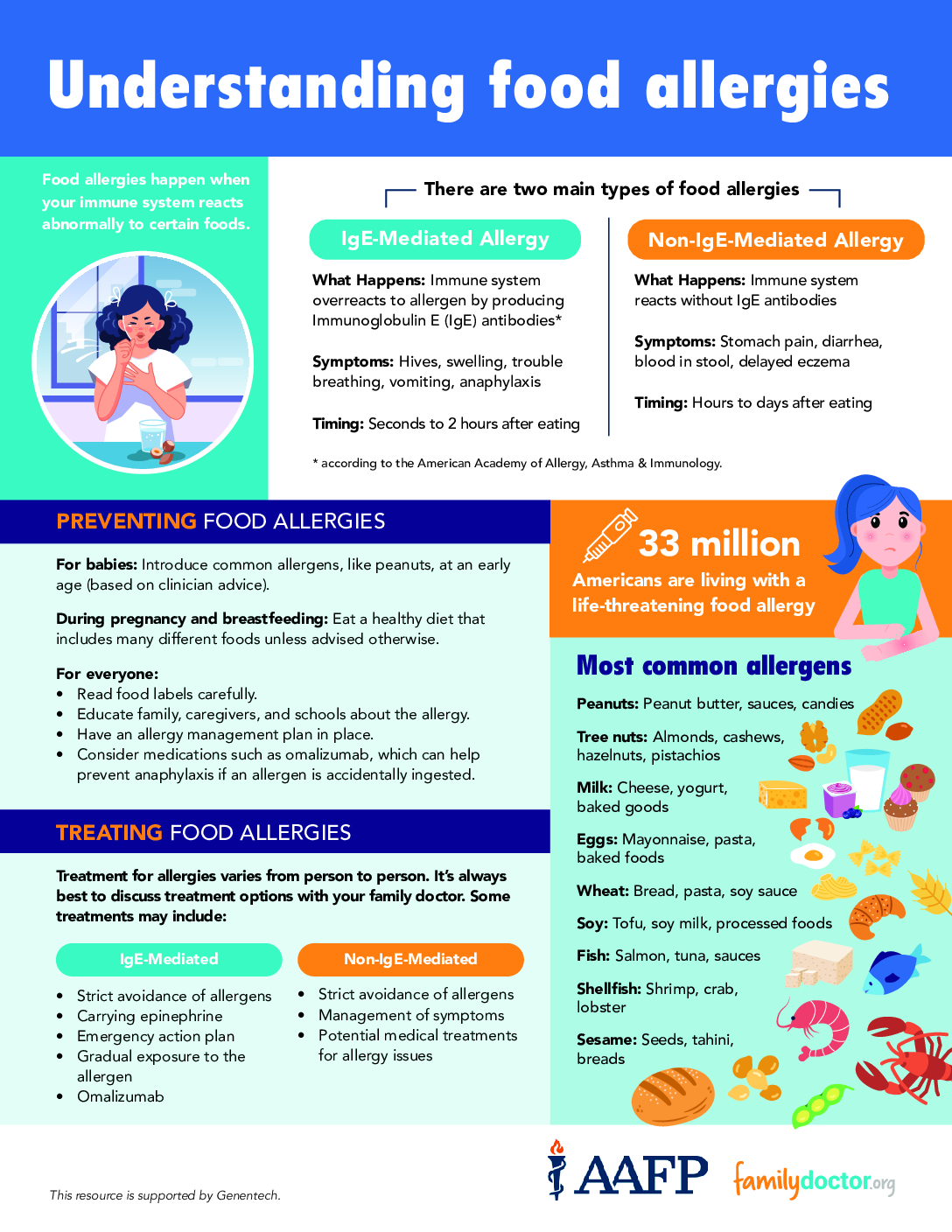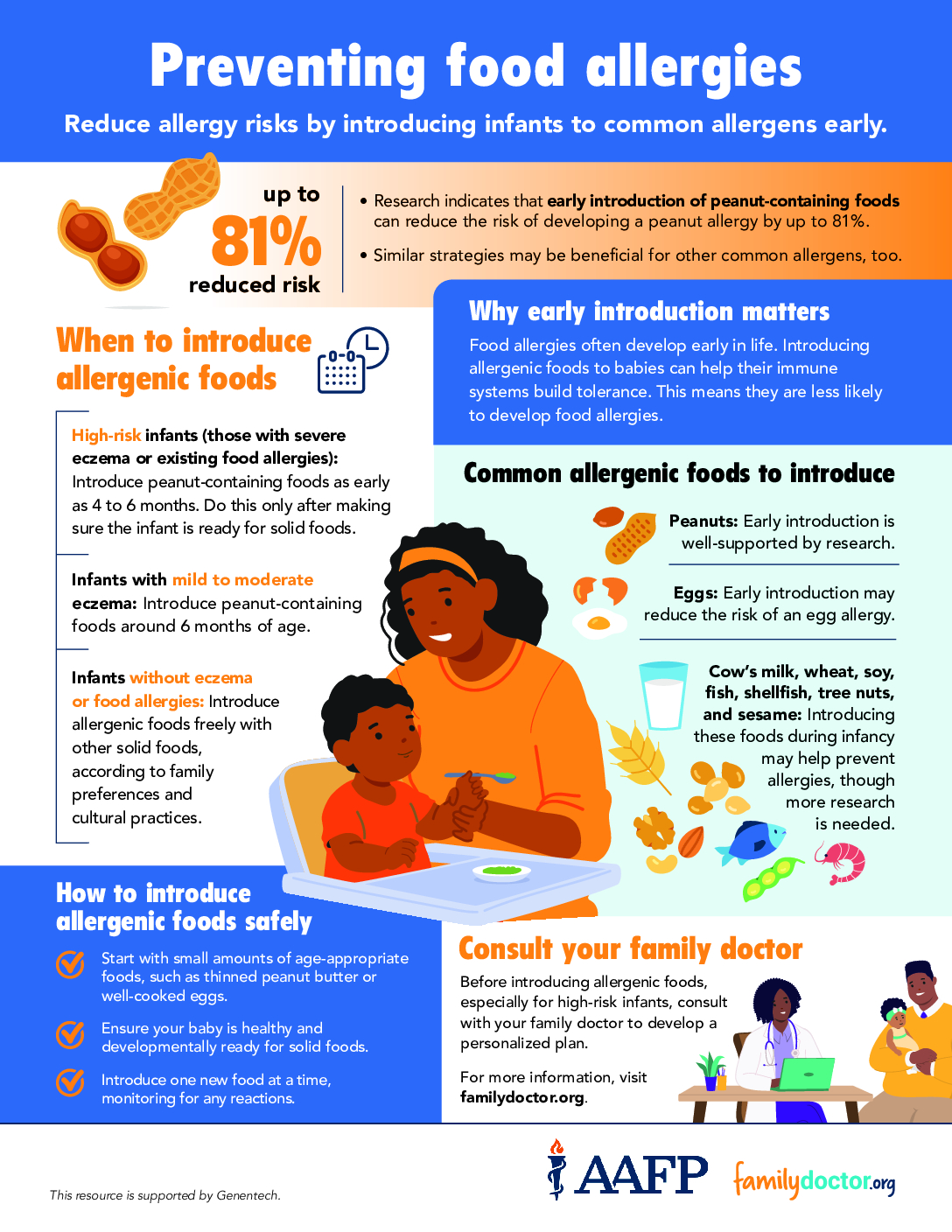
What is anaphylaxis?
Anaphylaxis is a life-threatening, whole-body reaction that often occurs when you are exposed to certain foods (different from food intolerance), insect bites/stings, certain medicines, and latex. Anaphylactic reactions can range in severity and not all allergic reactions lead to anaphylaxis. But when it does occur, you need immediate medical attention or to call 911.
Understanding anaphylaxis: Key facts and causes
- There are 33 million Americans living with a life-threatening food allergy. Of that total, one in 13 children have life-threatening food allergies. Between 150 and 200 deaths per year are caused by allergic reactions to food.
- Approximately 40 deaths per year are caused by allergic reactions to insect stings.
- About 400 deaths per year are caused by allergic reactions to medicine.
- Between 1-6% of Americans have a latex allergy.


There are simple ways you can ease mild reactions to a bee sting and avoid getting stung again. Read More
Symptoms of anaphylaxis
The primary symptom of anaphylaxis is a blocked airway and requires immediate 911 medical attention. Generally, symptoms are sudden (within 5 to 30 minutes of exposure) and vary based on degree of allergy and the amount of exposure. They range from mild to severe. Possible symptoms (or warning signs) include:
- Swelling in your mouth, throat, or other body part
- Hives, rash, or itchy skin
- Pale skin, or skin that is red and warm (flushed)
- Trouble breathing or gasping for breath
- A tight feeling in your chest
- Dizziness
- Fainting
- Stomach pain
- Nausea, vomiting, or diarrhea
- A feeling of anxiety
- Low blood pressure
- Cardiac arrest
What causes anaphylaxis?
The most common causes of anaphylaxis are reactions to foods (especially eating or touching peanuts), medications, and insect stings. Other causes include exercise and exposure to latex. Sometimes the cause is unknown. During a normal reaction, your body makes antibodies to fight the allergen. During a severe reaction, your immune system can panic. This leads to anaphylaxis.
Know these causes of anaphylaxis:
- Foods such as shellfish, nuts, peanuts, eggs, and fruits
- Medicines, such as antibiotics, aspirin, over-the-counter pain relievers, allergy shots, and contrast dye used in imaging procedures, such as MRIs, etc.
- Latex or rubber found in surgical gloves, medical supplies, and many products in your home
- Insect stings, such as from bees, wasps, hornets, yellow jackets, sawflies, and fire ants
Most people who have food allergies are allergic to fewer than four foods. Additionally, some food additives, such as yellow food dye and aspartame (artificial sweetener), can cause an allergic reaction. Although sugar and certain fats are not considered healthy choices, they are not associated with food allergies.
Some things may increase the risk for anaphylaxis:
- Previous anaphylaxis. If you’ve had anaphylaxis once, your risk of having this again increases. Future reactions could be worse than the first time.
- Allergies or asthma. People who have either condition are at increased risk of having anaphylaxis.
- Certain medical conditions. These include heart disease and an irregular accumulation of a certain type of white blood cell (mastocytosis).
How to identify and avoid anaphylaxis
Unless you have known risk factors for anaphylaxis, you won’t know if it could happen to you. However, you know you are at risk, here’s how to reduce your risk for a reaction:
- Avoid eating or touching any foods you are allergic to. Ask restaurant servers about the ingredients in the food you order, including peanuts (and peanut sauce), shellfish, eggs, and fruits. Be sure to tell your server you have an allergy to the ingredient in question.
- Read the ingredients and all other important warnings on labels of packaged goods. Even if a product doesn’t contain the ingredient you are allergic to, it may have been manufactured in a facility that is exposed to those ingredients. For example, packaged sugar cookie dough may come with a warning that it was made near other products containing peanuts.
- Tell all your health care providers what you are allergic to.
- If you are allergic to insect stings, wear protective clothing and insect repellent when you are outside.
- Wear a medical alert necklace or bracelet to indicate you have an allergy to specific drugs or other substances.
- Prepare and always carry an emergency kit with you that contains the medicines you need to treat your allergic reaction. For example, if you have been prescribed an EpiPen (epinephrine) to treat a peanut allergy, make sure it is in the kit and with you for immediate care. Regularly check to see if your medicine is filled and its expiration date. Teach family, friends, and coworkers how to use it. After treatment, you should have someone stay with you for 24 hours to make sure another attack does not occur. Your kit may also include an antihistamine, such as diphenhydramine (brand name: Benadryl).

How is anaphylaxis diagnosed and tested?
If you don’t know if you are allergic to something, you may only find out if you have a reaction. If you suspect you are allergic to something, talk to your doctor about testing for that item. Your doctor will identify your food allergy as one of two types:
- Immunoglobulin E (IgE)‐mediated: This is when your immune system produces IgE antibodies, which can lead to hives, swelling, trouble breathing, vomiting, and anaphylaxis within seconds to two hours after consuming the trigger food.
- Non-IgE-mediated: This is when your immune system reacts without IgE antibodies. With this type, you can experience stomach pain, diarrhea, blood in stool, and delayed eczema within hours to days after being exposed to the trigger item.
Your doctor will also ask about your health history and risk factors. Be prepared to give your doctor as much history as possible about your allergic reaction Some things to note include:
- The symptoms you have after exposure to certain things
- How long after the exposure these symptoms occurred
- How much exposure you had
- How often the reaction has occurred
- Whether it occurs in other situations
- Whether it occurs every time you are exposed to the same thing
- What type of medical treatment, if any, you received after having symptoms
If you have a food allergy, your doctor may put you on an elimination diet. This is when you don’t eat any suspicious foods for a while then gradually add them back one at a time. Your doctor also may perform a blood test to measure the levels of IgE antibodies specific to different foods. Elevated levels of IgE for a specific food suggest a possible allergy.
Your doctor may perform an oral food challenge (OFC) test. It is considered the gold standard in testing for food allergies. It involves a person eating increasing amounts of the suspected allergen (under medical supervision) until they reach the amount that might trigger a reaction. If no reaction occurs, the person can usually continue to eat that food.
Once a food allergy is diagnosed, avoid the food that causes it. If you have an allergy, you must read the labels on all prepared foods you eat. Your doctor can help you learn how to avoid eating the wrong foods.
Another allergy test is a skin prick test. It works like this:
- A medical professional will apply a small amount of liquid containing a suspected allergen on your skin.
- They will lightly prick your skin under the drop to allow the allergen to penetrate.
- If a raised, red, itchy bump (wheal) develops within 15-30 minutes, it indicates you may have a possible allergy.
Pediatric diagnosis and testing
Testing children for allergies in children may differ slightly. The most common allergen concern for children is peanuts. Recent studies have found that some food allergies — such as peanut allergies — can be prevented if they are introduced and treated within the baby’s first year. The National Institute of Allergy and Infectious Diseases recommends that infants with severe eczema, egg allergy, or both be introduced to foods containing peanuts as early as four months of age to reduce the risk of a peanut allergy. Talk to your doctor before introducing foods containing peanuts at this early age.
Similar strategies may be beneficial for other common allergens, too. Always talk to your doctor first. They typically follow this testing plan:
- High-risk infants (those with severe eczema or existing food allergies): Introduce peanut-containing foods as early as four to six months. Do this only after making sure the infant is ready for solid foods.
- Infants with mild to moderate eczema: Introduce peanut-containing foods around six months of age.
- Infants without eczema or food allergies: Introduce allergenic foods freely with other solid foods, according to family preferences and cultural practices.
Common allergenic foods to introduce
- Peanuts: Early introduction is well-supported by research.
- Eggs: Early introduction may reduce the risk of an egg allergy.
- Cow’s milk, wheat, soy, fish, shellfish, tree nuts, and sesame: Introducing these foods during infancy may help prevent allergies, though your doctor’s guidance and more research is needed.
How to introduce allergenic foods safely to children
- Start with small amounts of age-appropriate foods, such as thinned peanut butter or well-cooked eggs.
- Ensure your baby is healthy and developmentally ready for solid foods.
- Introduce one new food at a time, monitoring for any reactions.
If your child has food allergies, give their school and other care providers instructions on what foods to avoid. Tell them what to do if the food is accidentally eaten. Many children usually outgrow allergies to milk, eggs, soybean products, and wheat. People rarely outgrow allergies to peanuts, tree nuts, fish, and shellfish.

Preventing anaphylaxis: Steps to stay safe
If you or someone around you has anaphylaxis, call 911 immediately. Call your doctor if you have milder symptoms of anaphylaxis. Most important is to avoid the items that caused the allergic reaction.
If you have a food allergy, eliminate the possibility of cross-contamination in food preparation areas. An example of this is to properly wash and sanitize your hands, cutting boards, and utensils that were used to prepare the food that causes the allergic reaction. Plan for direct exposure and cross-contamination by talking with your hosts who are preparing food in their home. Inform restaurant servers and read the instructions on prepared food packaging.
Emergency preparedness: Handling anaphylaxis
Treatment for anaphylaxis should begin immediately. If you see someone have a reaction, call 911 to get medical help. If the person has an emergency kit with an EpiPen, inject it into the muscle of their arm or leg. An EpiPen is a short-term treatment. The person still should go to the hospital for treatment and care. Certain allergies may require a series of desensitization shots.
If you have a mild reaction (itching, sneezing, hives, or rash) to an allergen, your doctor will give you antihistamines and oral or topical steroid medicine.
Also, plan by preparing for known allergies by creating an individual or family emergency plan. This contains information about what item the individual is allergic to and how to respond with medicine or calling 911.
Keep multiple emergency anaphylaxis kits with you to keep at home and to carry with you when you leave your home.
Practical tips for managing anaphylaxis due to allergens
Living with allergies to food, insect bites/stings, medicines and latex can cause fear and anxiety. Ease your mind by avoiding your known allergen triggers, speaking up with family, friends, and restaurant servers, and talk to your doctor regularly. There may be new medicines to treat your allergies. Also, certain allergies may benefit from a series of desensitization shots to reduce the seriousness of your reaction when you are exposed.
Questions to ask your doctor
- How should I handle having a food allergy reaction?
- Is the first bad reaction usually mild or severe?
- Are food allergies inherited?
- Do symptoms appear in a certain order to give you some warning?
- Can you develop food allergies later in life?
- Can peanut allergies be prevented in infants?
![]()
Copyright © American Academy of Family Physicians
This information provides a general overview and may not apply to everyone. Talk to your family doctor to find out if this information applies to you and to get more information on this subject.








